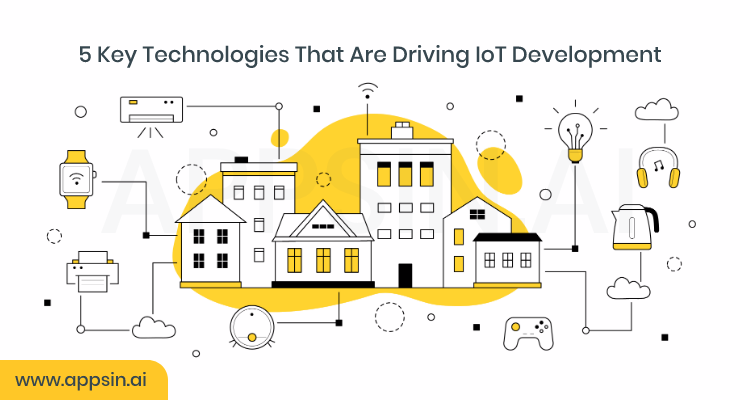5 Key Technologies Fueling the Advancement of IoT
- Author: Princee Rithikka
- Posted On: August 17, 2023
- Post Comments: 0
5 Key Technologies Fueling the Advancement of IoT
The Internet of Things (IoT) is rapidly transforming the way we interact with the world around us. As the digital landscape continues to evolve, several key technologies are playing a pivotal role in driving the development of IoT. From connectivity solutions to data processing and security measures, these technologies are shaping the future of IoT applications. In this article, we will explore the five key technologies that are at the forefront of IoT development.
Future of IoT
In the past few years, the significant increase in digitalization has occurred due to the availability of cheap resources accessible to everyone. These resources have enabled each individual to embrace these trends.
The integration of the Internet of Things (IoT) has seamlessly woven into various aspects of our globalized economy and way of life. This integration spans from interconnected consumer products like appliances, security systems, and automobiles to significant manufacturing applications in sectors such as agribusiness and power.
According to Finance Online, the usage of IoT devices is expected to exceed $25 billion within the next seven years.

5 Key Technologies Fueling the Advancement of IoT
Here are five pivotal technologies driving IoT development:
Edge Computing: Processing Data at the Source
5G Connectivity: Powering Seamless Communication
Security Solutions: Safeguarding IoT Ecosystems
Digital Twins
Blockchain
IoT devices churn out a massive volume of data, but sending all of this data to a centralized cloud for processing could result in latency and bandwidth challenges. Edge computing resolves this problem by handling data at or close to the origin, minimizing the necessity for remote data centers. This technology empowers faster response times and more effective data management. It proves exceptionally beneficial in scenarios where real-time decision-making holds paramount importance, such as industrial automation and remote monitoring.
According to Statista, the domain of edge computing has burgeoned into a vast and rapidly expanding market. It is projected that global revenue will soar to 274 billion US dollars by 2025.
The fifth-generation (5G) wireless technology is actively driving the advancement of IoT with its unmatched speed, low latency, and capability to simultaneously connect a vast number of devices. 5G is revolutionizing IoT applications by enabling real-time communication between devices, rendering it perfect for implementing applications such as autonomous vehicles, remote surgery, and smart city infrastructure. 5G's high-speed connectivity establishes the foundation for IoT growth, allowing the creation of more intricate and responsive networks.
As IoT devices increasingly integrate into our lives, we cannot overstate the significance of implementing robust security measures. Cyberattacks can exploit each connected device as a potential entry point. To enhance IoT security, experts are utilizing technologies such as blockchain and secure element chips. The decentralized nature of blockchain can thwart unauthorized access and data tampering, while secure elements offer hardware-based security for devices, shielding them against diverse forms of intrusion.
A digital twin represents a virtual or digital copy of a physical object, system, or process. It's a technological concept that encompasses the creation of a virtual counterpart for real-world entities, which can span from individual objects to complete systems. The aim of a digital twin is to facilitate enhanced comprehension, analysis, monitoring, and control of the real-world entity that it depicts.
The digital twin has garnered increased attention since its recognition in 2020, owing to its remarkable results. Experts foresee a staggering annual expansion rate of 58 percent between 2021 and 2026. In recent years, the real estate industry has also adopted digital twins to enhance ideation and collaboration.
In the wake of the COVID-19 pandemic, organizations are actively striving to establish dependable supply chains and logistical solutions, with digital twins expected to assume a vital role in accomplishing this objective.
The increased adoption of blockchain technology is one of the latest trends in the Internet of Things (IoT). Blockchain technology ensures data security in IoT devices, enables thriving interaction between various network nodes, and assures safe record-keeping. This makes Blockchain a great fit for IoT applications due to its distributed nature. Markets and Markets estimates that the global blockchain IoT market size will grow by USD 2,409 million by 2026. Decentralized and distributed ledger technology, known as Blockchain, is currently taking over applications in banking, agriculture, finance, transportation, and other fields. The combination of this technology with the Internet of Things leads to plausible advancements.
Conclusion
In conclusion, the evolution of IoT is being propelled by a synergy of various technologies. From seamless connectivity provided by 5G to localized processing through edge computing, the integration of AI/ML for intelligent decision-making, robust security measures, and specialized connectivity solutions like LPWAN, these technologies collectively form the foundation of IoT's expansion. As these technologies continue to advance, we can anticipate a future where IoT applications become even more diverse, impactful, and integrated into our daily lives.

